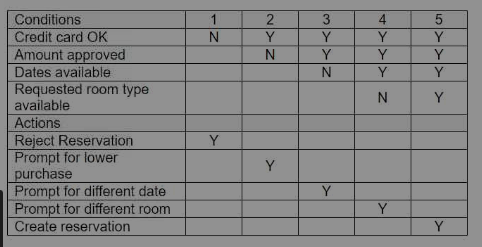iSQI CTAL-TA_Syll2019 ISTQB Certified Tester Advanced Level - Test Analyst (Syllabus 2019) Exam Practice Test
You are assigned as a Senior Test Analyst to lead a project test team composed of business users. These users have extensive business knowledge, but no testing experience. There is another test team composed of in-sourced professional testers that will also be used for this project. Your business users will be assisting the project on a part-time basis. The development team is building an application using the "V-model" development lifecycle. Your company has automated testing tools and test management systems for use by dedicated test teams. What would be an effective method to employ your business users in your testing effort?
While experience-based testing can be very effective, it does have some drawbacks. What is a drawback of experience-based testing?
In the initial release of an insurance risk assignment application, a variety of test techniques were employed, especially equivalence partitioning.
After a thorough root cause analysis of this release, it was determined that the developers tended to incorrectly use ">" and "<" rather than the ">=" and " <= " in the code at several decision points.
This caused several borderline cases to be handled incorrectly.
Based on this analysis, how would you modify your test strategy for the next version's release?
Answer : B
Boundary value analysis is a technique that focuses on testing the values at the boundaries of valid and invalid partitions. It is suitable for testing the errors caused by incorrect use of relational operators in the code, such as ''>'' and ''<'' instead of ''>='' and ''<=''. By creating test cases using boundary value analysis, the tester can verify that the system handles the borderline cases correctly and does not miss any edge cases.
Reference=
ISTQB Advanced Level Test Analyst Syllabus 2019, Section 3.2.2.2, page 411
Software Testing - Boundary Value Analysis - GeeksforGeeks2
State Transition Testing -- Diagram & Technique (Example) - Guru993
You have been provided with the following decision table that was used for smoke testing the previous release of a set of hotel reservation software.

During discussions with the Test Manager you agreed that software behavior focused on the date of reservation, especially as midnight approaches, presented additonal risk.
You need to add more tests to provide more thorough coverage of the test conditions. Which of the following techniques should you use to design more tests?
You have been working as a Test Analyst for a customer-facing application that is critical to the reputation of your company. You have worked with business users to create use
cases and captured a variety of scenarios, including both main and alternate paths. You have managed to create a suite of use cases that portrays a realistic usage model of the system.
Because of this, you will also be able to use these use cases for what other type of testing?
Answer : B
Use cases can be used for performance testing to measure the response time and throughput of the system under different workloads and scenarios. Use cases describe the process flows through the system based on its most likely use, which can help to simulate realistic user behavior and identify potential bottlenecks and performance issues.
Reference=
ISTQB Advanced Level Test Analyst Syllabus 2019, Section 3.2.2.2, page 411
How to write a performance test case | MyLoadTest2
Performance Testing Types, Steps, Best Practices, and Metrics - Stackify3
Supercar is an online vehicle sales website specialising in a single manufacturer's Sports Utility Vehicles (SUVs) and saloons. A vehicle has two key elements, power unit and body style. The manufacturer offers three choices of power unit: petrol, diesel and hybrid. There are 3 mam body styles Saloon, Hatchback and SUV SUVs only come as petrol and diesel options Hybrid is available for Hatchback only. The site will allow an order to be processed if at least one of the chosen vehicle configurations is in stock, otherwise a message will be displayed asking the user to try again later As a Test Analyst you are asked to review the Supercar specification before starting to design the corresponding usability test cases. Which of the comments below should you make?
You are a Test Analyst in the banking domain. You have received the following requirement: "The system shall allow cash advances of at least 200 Euros for all supported credit cards. The following credit cards are supported: American Express, Diners, Visa, Mastercard and Eurocard.
Which one of the findings described below is true regarding this requirement?